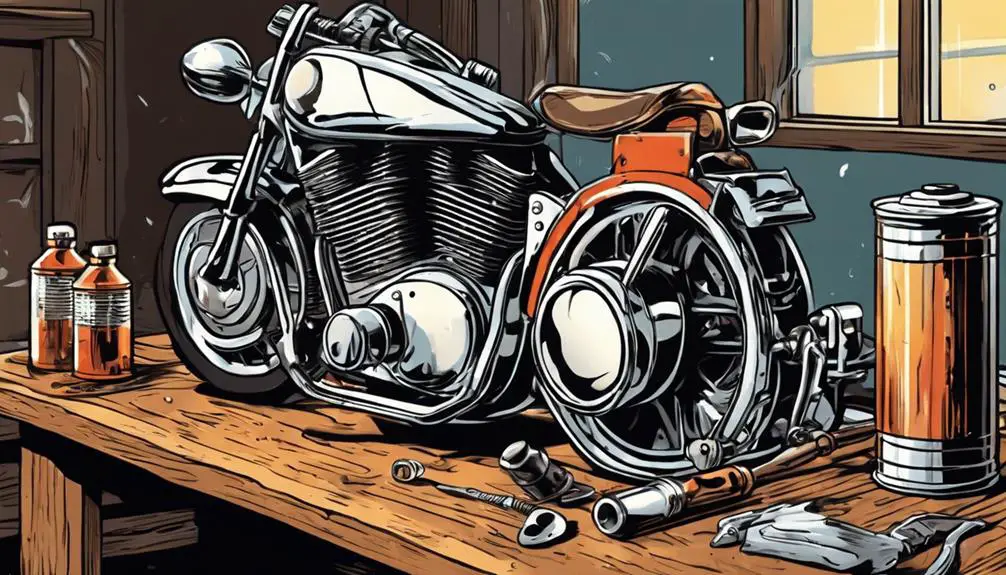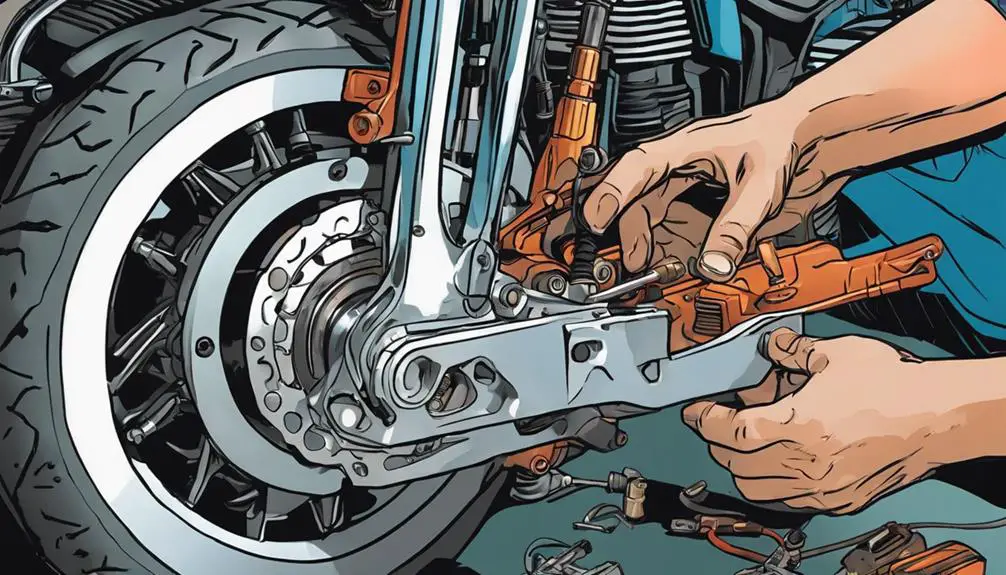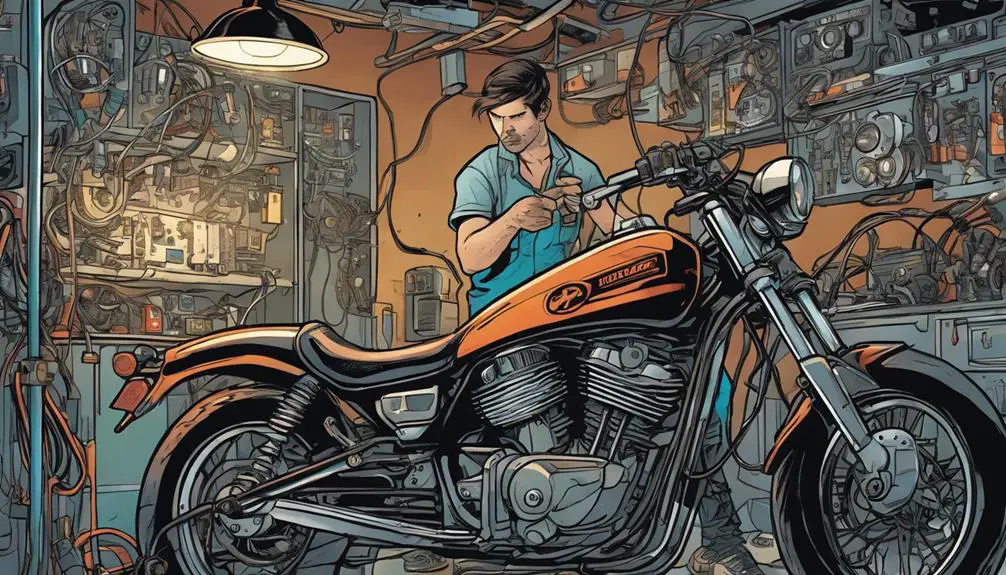When you've got an iconic motorcycle, keeping it in top shape is vital for performance and longevity. You can't afford to overlook routine maintenance, as it plays a significant role in your riding experience. From regular oil changes to tire pressure checks, each aspect demands your attention. But what about those often-neglected areas that could save you from unexpected issues on the road? Let's explore the five essential tips that could make all the difference in your ride's reliability and enjoyment. You might be surprised by what you discover.
Key Takeaways
- Perform regular oil changes every 3,000 to 5,000 miles, replacing the oil filter for optimal engine health.
- Maintain proper tire pressure and inspect for wear to ensure safe handling and performance.
- Regularly check brake fluid levels and inspect pads and rotors for effective braking performance.
- Keep the chain lubricated and inspect sprockets for wear to prolong lifespan and enhance ride quality.
Regular Oil Changes

Regular oil changes are essential for keeping your motorcycle running smoothly and efficiently. When you change your oil regularly, you're not just maintaining your engine; you're ensuring that every ride feels liberating and powerful. Fresh oil lubricates the moving parts, reduces friction, and helps prevent overheating, which means you can hit the open road with confidence.
You should check your oil level frequently. If it's low or dirty, it's time for a change. Most manufacturers recommend changing the oil every 3,000 to 5,000 miles, but always consult your owner's manual for specifics. Don't forget to replace the oil filter, too; it's a small investment for the freedom of having a well-functioning bike.
When you're ready to change your oil, gather your tools and find a clean space. Pour in high-quality oil that fits your bike's specifications, and feel empowered knowing you're taking charge of your ride's performance.
Embrace the ritual of oil changes as part of your motorcycle journey; it's a way to connect with your machine. By prioritizing regular oil changes, you're ensuring that every twist of the throttle brings you closer to the liberation of the open road.
Tire Maintenance Practices
Taking care of your tires is just as important as keeping up with oil changes, as they play an essential role in your motorcycle's performance and safety on the road.
Start by checking tire pressure regularly. Under-inflated tires can lead to poor handling and increased wear, while over-inflated tires may cause a bumpy ride. Always refer to the manufacturer's specifications for the correct pressure.
Next, inspect your tires for any signs of wear or damage. Look for cracks, bulges, or punctures. If you notice uneven wear patterns, it might be time to rotate or replace your tires.
Don't forget to check tread depth, either. Tires with inadequate tread can compromise grip, especially in wet conditions. You can use the penny test: insert a penny into the tread; if you can see all of Lincoln's head, it's time to replace those tires.
Lastly, clean your tires regularly. Dirt and debris can affect traction. A quick wash will help maintain their condition and performance.
Brake System Checks

Confirming your brake system is in top condition is vital for your safety and control while riding. You've got the freedom of the open road, but without proper brakes, that freedom can quickly turn into a nightmare.
Start by checking your brake fluid levels; they should be clear and at the recommended level. If the fluid looks dark or murky, it's time for a change.
Next, inspect your brake pads. Look for wear indicators—if they're worn down, replace them to guarantee you've got the grip you need.
Don't forget to check your rotors for warping or scratches; smooth and intact rotors are essential for effective braking.
You should also squeeze the brake lever and listen for any unusual noises. If you hear squeaking or grinding, it's a sign that something's off. Finally, test your brakes at low speeds to verify they engage smoothly and without resistance.
Regular brake system checks empower you to ride with confidence, knowing your motorcycle can stop when you want it to. Embrace the ride, but remember: your brakes are your best ally in maintaining that liberating experience.
Chain and Sprocket Care
Proper chain and sprocket care is essential for maintaining your motorcycle's performance and extending its lifespan. You want your ride to feel smooth and responsive, so start by regularly inspecting your chain for any signs of wear or damage. Look for stiff links and rust, as these can hinder your freedom on the road.
Next, keep your chain properly lubricated. A well-lubed chain reduces friction and wear, allowing you to release your bike's full potential. Clean the chain with a dedicated cleaner and apply the lubricant evenly, ensuring you hit all the vital spots.
Don't forget about the sprockets! Check for signs of wear, such as hooked teeth or uneven surface wear. If you notice any issues, it's time to replace them to avoid jeopardizing your chain's integrity.
Lastly, adjust your chain tension according to your motorcycle's specifications. Too loose or too tight can lead to poor performance and potential damage.
Electrical System Inspection

A well-maintained motorcycle isn't just about the chain and sprockets; checking the electrical system is just as important for a smooth ride. You rely on your bike's electrical components to power your lights, ignition, and even your accessories. So, take a moment to inspect the wiring, connectors, and the battery.
Start with the battery—confirm it's securely mounted, clean, and free of corrosion. Check the terminals for tight connections and verify it's holding a proper charge.
Next, examine the wiring harness for frayed or exposed wires that could lead to shorts. If you spot any damage, replace the wires to avoid any future mishaps.
Don't forget about the fuses. A blown fuse can disrupt your ride and leave you stranded. Test each fuse and replace any that are burnt out.
Frequently Asked Questions
How Often Should I Clean My Motorcycle's Air Filter?
You should clean your motorcycle's air filter every 5,000 to 10,000 miles, but it really depends on your riding conditions.
If you're often in dusty environments or ride hard, check it more frequently.
A clean air filter guarantees your engine breathes well, boosting performance and efficiency.
What Is the Best Way to Store My Motorcycle During Winter?
When winter rolls around, you want to store your motorcycle properly.
First, clean it thoroughly to prevent corrosion.
Then, fill the tank with gas and add a fuel stabilizer.
Disconnect the battery to avoid drainage and cover your bike to protect it from dust.
Keep it in a dry, temperature-controlled space if possible.
That way, when spring comes, you'll be ready to ride without any hassle or worries!
How Can I Prevent Rust on My Motorcycle?
To prevent rust on your motorcycle, you've gotta keep it clean and dry.
Regularly wash off dirt and grime, especially after rides in wet conditions.
Apply a protective wax or sealant to create a barrier against moisture.
Don't forget to lubricate metal parts and check for any scratches or chips in the paint that could expose bare metal.
Finally, consider using a dehumidifier when storing it in damp environments.
Stay ahead of rust!
When Should I Replace My Motorcycle Battery?
When you notice your motorcycle struggling to start, that's a clear sign it's time to think about replacing the battery.
If you find yourself jump-starting it more often than usual, don't ignore that! A battery typically lasts 3 to 5 years, depending on how you ride.
What Type of Fuel Should I Use for My Motorcycle?
When it comes to choosing fuel for your motorcycle, you should always check the owner's manual for the manufacturer's recommendations.
Most bikes run on regular unleaded, but some high-performance models might require premium fuel.
It's essential to avoid using ethanol-blended fuels if your bike isn't designed for them, as they can cause damage.
Conclusion
By following these five essential maintenance tips, you're not just keeping your iconic motorcycle in top shape; you're ensuring every ride is a thrilling adventure.
Imagine hitting the open road, the wind in your hair, and knowing your bike is ready for anything.
But what happens if you neglect even one of these vital areas? The answer could lead to unexpected challenges on your next journey.
Don't let that happen—take charge and keep your ride legendary!